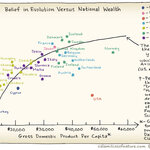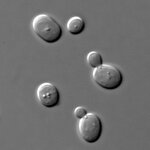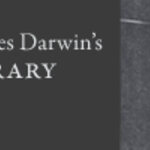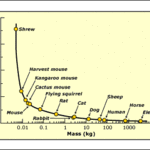Evolution

Greetings,I came across this plot, and decided to post it here.
Figure: Plot that shows the correlation between the percentage of the public the accepts evolution and the GDP per capita.(Source: Calamities of Nature)
So, what can we learn from this plot?
1. The higher the GDP per capita, the more people accept evolution (important note: it's a correlation, not necessarily a causal connection).
2. The acceptance of evolution still has a long way to go (the highest acceptance rates hover around 80%, which means that even here 1 out of every 5 people don't accept evolution!).
3.…

Between Easter’s religious reminders and a molecular evolution class overdose of population genetics, I shouldn’t have been surprised to wake up yesterday from an unsettling dream about taking my midterm exam on Noah’s Ark. The ocean was rising, Noah was hustling animals aboard, and I was battling asthma (thanks, furry animal allergies). But what bothered me most about all this wasn’t that I’d forgotten the formula for heterozygosity. It was that there were only two animals of every kind.
Religious beliefs aside, today’s scientific consensus is that you need more than two individuals to save…

Sex is costly. Yet it is widespread throughout the animal kingdom, so there must be some advantages to it. And still, it seems easier to list disadvantages. Sexual reproduction is complicated, requires more time and uses more energy than its asexual counterpart. Partners have to find each other and coordinate their activities to produce the next generation. Another problem is the so-called ‘cost of meiosis’, meaning that, in sexual reproduction, only half of the genome is passed on. Compared to an asexually producing individual which passes on its entire genome, this is a high cost indeed.…

Botany: A Blooming History
And now we return to part one of this series
1. A Confusion of Names
We now meet Thomas Fairchild (1667? – 1729). Wikipedia is rather terse about him:
He corresponded with Linnæus, and he helped by experiments to establish the existence of sex in plants; and he was also the first person who succeeded in scientifically producing an artificial hybrid. This was Dianthus caryophyllus barbatus, a cross between a sweet william and a carnation pink.
In 1722 he published a small book, The City Gardener, devoted to a description of…

Harry Lonsdale, a 79 year old millionaire scientist, has launched a $50,000 prize to promote research in the origin of life. The prize could potentially be complemented by $2,000,000 (!) of research funding.
Harry Lonsdale is a chemist in Bend, Oregon, who made a fortune when he sold his drug development and research company to Pfizer more than 25 years ago. Since then, he has leveraged his wealth for social, civic, and political causes, including a series of unsuccessful bids to become a U.S. senator. The 79-year-old Lonsdale is an avowed atheist who has advocated for gay rights, campaign…

The term sperm competition can be used in two ways.
In the broad sense, it involves a large range of morphological, behavioural and physiological attributes, including courtship and copulation behavior (for example, a male that guards females to ensure that he’s the father).
In the narrow sense, which is the focus of this article, sperm competition is used to denote the physiological processes occurring inside the female’s genital organs after multiple matings.
(For a brief review on the complexity of sperm selection, see Wigby and Chapman, 2004).
When it comes to sperm competition in…

The world is changing. Climate change, deforestation, and much more, are all having an impact on our litlle planet. A question that follows this statement quite naturally, is 'Will the earth's organisms be able to adapt to the changing circumstances?'
Well, probably, some will, given enough time. But that might be a problem.
The world is changing fast. So the question should really be 'Will the earth's organisms be able to adapt to the changing circumstances fast enough?'
To test this, researchers at McGill University decided to track the fate of more than 2000 populations of yeast (…

Charles Darwin was, among many things, an avid reader, and by the end of his life he had created his own small library. Not only did he read a lot, but he also compared his ideas with those proposed by the authors, which becomes clear when noticing the copious amount of annotations he added to the texts he was reading. And now, everyone can see these. The most heavily annotated works from Darwin's library have been digitized by the Biodiversity Heritage Library.
(Source: Biodiversity Heritage Library)
Browsing through Darwin's books, a helpful window is provided where his - at times…

If Hollywood movies are your science guide, outer space is populated primarily by hot vampire girl aliens and time travel is not only possible, but chicks will dig you more, the same way women today would like a man in a powdered wig and no bath for three days if he suddenly appeared from 1811.(1)Science hates to be a buzzkill but often must - having sex with someone from the future might shorten your lifespan, thanks to antagonistic coevolution.
Writing in Evolution, researchers outline how they preserved previous generations of brine shrimp (Artemia franciscana) - A 20-year period, so over…

Recently, research has been conducted to see if certain life-history traits could be correlated with DNA mutation rates. By using whole-genome sequence data for 32 species of mammal, the researchers tested the hypothesis that DNA mutation rates are influenced by species-specific life-history traits. These mutation rates were estimated by looking at the rate of substitutions of neutrally evolving DNA segments.
This type of research could make it possible to infer life-history information of extinct species, providing that genomic data is present.
The research focused on three life-…